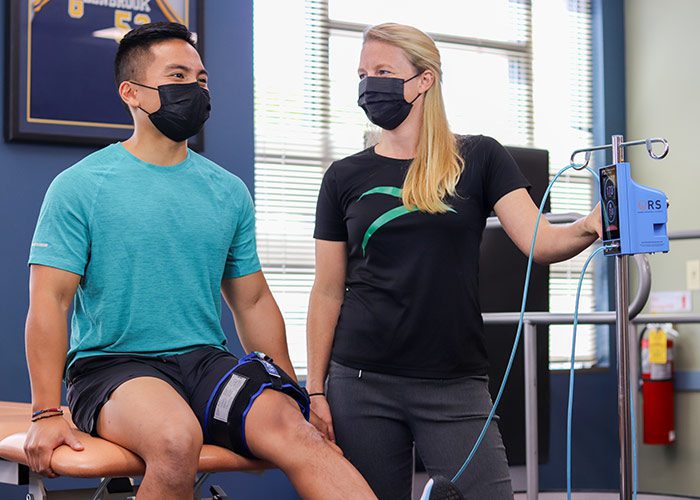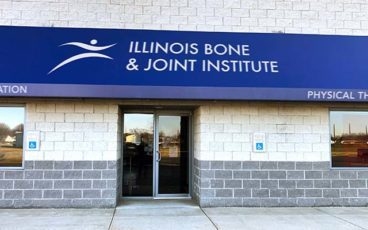Q&A with BFR-Certified Physical Therapist Carrie Dinelli

IBJI Physical Therapist Carrie Dinelli, right, performs BFR therapy on a patient.
A safe and effective therapy that is becoming more prevalent across IBJI has been most helpful with patients who are post-op and recovering athletes. In this blog, we’ll discuss everything you need to know about blood flow restriction therapy, including how it works, who it helps and why it’s safe.
Q: What Is BFR Therapy and What Are the Benefits for Recovery?
Carrie: BFR therapy is a technology that has been utilized in physical/occupational therapy at IBJI for approximately two years and is gaining in popularity among patients and staff. It is used to help patients in the recovery process from surgery/injury by reducing atrophy and promoting growth of the muscle, decreasing pain, improving tissue healing, and lessening chronic muscle strain or guarding.
I have found it to be helpful working with my athletes who are used to participating in high level activities. They can do “simple” exercises and still feel the muscle burn and fatigue that they’re used to perceiving with their normal training. The athlete can stay engaged and motivated by performing strengthening exercises while using the BFR equipment, which can facilitate a positive mental attitude about their recovery.
Q: What Causes Muscle Atrophy?
Carrie: After surgery or an injury, there may be mobility or weight-bearing restrictions placed on the injured body part to protect the repaired tissue and promote healing. While this is an important aspect of the post-surgical protocol, with it comes lack of muscle use/activation and it gets smaller, or atrophies. For example, after an ACL reconstruction surgery, the patient will often look at themselves in the mirror and notice that the thigh of their surgical side is smaller than the other. Why? The quadricep has atrophied.
By implementing BFR early and often, you can work to decrease the atrophy and facilitate the growth of the quadricep muscle to prepare it to support your full weight when restrictions are lifted. BFR is also regularly used after rotator cuff surgery, for similar reasons, as the patient is not allowed to use the arm to lift, carry or perform other dynamic exercises, leading to muscle atrophy.
Q: Who Administers BFR Therapy at IBJI?
Carrie: BFR is a safe modality used by a licensed medical professional. At IBJI, we have physical therapists, physical therapy assistants, certified athletic trainers and occupational therapists who are BFR-certified. We have 48 clinicians across 18 locations who have been certified to perform BFR, which means they completed an 8-hour course where they learned the didactics of BFR, practical application and clinical use, and passed a test at the end of the course.
Q: Can You Describe the BFR Therapy Equipment and How It Works?
Carrie: BFR therapy utilizes a piece of equipment (a tourniquet) similar to a blood pressure cuff to reduce the blood flow to the extremity to enhance muscle fiber activation. This advanced technology allows IBJI clinicians to reduce the duration of rehabilitation.
Each IBJI Rehab location offering BFR rehabilitation uses Delfi PTS equipment. This state-of-the-art system features a built-in, operational safety check prior to use. It has an automatic limb occlusion pressure control and a self-calibration device to ensure a safe delivery of care to the individual.
Our clinicians use fully computer-generated, personalized occlusion pressures rather than manual occlusion pressures that other systems deliver. Compared to traditional BFR units and tourniquets, the Delfi system allows IBJI Rehab to offer personalized, safe, efficient and accurate BFR intervention.
Q: What Type of Patient Can Utilize BFR Therapy?
Carrie: BFR therapy is best utilized with patients who recently underwent surgery, spent a period of time immobilized, or who have weight-bearing restrictions. It’s also beneficial for individuals who may have had surgery months ago, but never regained their full strength.
After ACL surgery performed by Dr. Roger Chams, Chicago Red Stars' soccer player
Alyssa Mautz regained muscle strength with BFR.
Q: When Is BFR Contraindicated?
Carrie: BFR therapy should not be utilized on patients with a history of DVT or impaired circulation, clotting risk, infection in the limb, open incisions, pregnancy, active cancer distal to the tourniquet site, or with an open fracture.
Q: Is There an Initial Consultation?
Carrie: Yes. It’s important that we take this time to educate the patient and their families on the benefits of BFR therapy so they are comfortable to start when medically ready. This modality cannot be implemented or started until all incisions are closed. We also consult with the surgeon or physician before implementing the treatment.
Q: Can You Describe a Typical Session?
Carrie: Patients should wear thin clothing so the cuff can get close to the skin and the machine can determine their limb occlusion pressure. The cuffs come in different sizes, so I select the appropriate cuff depending on the size of the patient’s limb.
I wrap the cuff either around the thigh for a lower extremity injury or the shoulder for an upper extremity injury. A tube connects to the cuff, and it takes the blood pressure of the arm or leg. The patient rests until the cuff is finished taking the maximum occlusion pressure. Then a percentage of the occlusion is set to either 60 or 80 percent, and exercises begin.
Q: How Long Do BFR Therapy Sessions Take?
Carrie: Sessions are one hour, but they typically start with a soft tissue massage and a warm-up. Each BFR exercise can take up to eight minutes max, and we typically do about three to five exercises, depending on the patient and their deficits.
Q: What Is the Length and Type of BFR Therapy Exercises?
Carrie: Each exercise is completed in four sets. The first set is 30 reps with a 30-second rest period, but the pressure in the cuff doesn’t change while the patient is resting. This is followed by three sets of 15 of the same exercise. The method challenges the muscles to reach a state of anaerobic demand, which helps reduce muscle atrophy. I let the patient know, ‘your leg is going to feel super heavy, the same feeling you get after an intense, loaded squat.’ The entire session consists of the following:
- 30 reps, 30-second rest
- 15 reps, 30-second rest
- 15 reps, 30-second rest
- 15 reps then done, and deflated
The rest period between different exercises is a full minute.
The exercises that encompass the routine are typically exercises that have been performed in the therapy sessions prior to incorporating BFR. Exercise selection progresses as the patient advances in their recovery.
Q: What Does BFR Therapy Feel Like?
Carrie: Patients describe it as a “strong squeeze” the whole time. They like that the machine keeps track of their reps, counting each one and alerting them with a beeping sound when the exercise has been completed.
For athletes, it feels like you’ve done a thousand squats, when all you’ve done is a simple leg raise or squeeze. It intensifies the workout through a different mode of exercise.
Q: How Often Do You Use BFR Therapy on Patients?
Carrie: Usually, it’s used at least three times a week on our patients. Once a patient utilizes the equipment, they want to continue the treatment. Our athletes appreciate the effects of the treatment, as they feel something happening in the muscle.
Q: How Long Is It Before BFR Sessions Are No Longer Needed?
Carrie: Post-op patients will graduate out of BFR therapy once they’re ready for higher level and more dynamic exercises, or when their muscle girth is comparable to their unaffected side. It’s often a four-week time frame, but could be longer. At that point, they can advance to more functional strengthening exercises to prepare them for sports specific training or fitness activities they’d prefer to do.
Interested in knowing more? Check out our blood flow restriction page.

